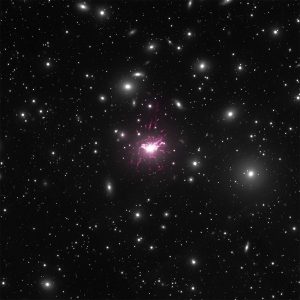Revealing the complexity of the nebula in NGC 1275 with SITELLE
Four researchers from the Center for Research in Astrophysics of Quebec (CRAQ), PhD student Marie-Lou Gendron-Marsolais and Professor Julie Hlavacek-Larrondo from the Université de Montréal as well as Professor Laurent Drissen and the postdoctoral researcher Thomas Martin of Université Laval used SITELLE, an instrument installed at the Canada-France-Hawaii Telescope (CFHT), to reveal for the first time the intricate dynamic in the galaxy NGC 1275.

Filamentary structure around the galaxy NGC 1275 in Ha.
Credits : SDSS/CFHT, Julie Hlavacek-Larrondo, Marie-Lou Gendron-Marsolais, Laurent Drissen and Maxime Pivin-Lapointe.
Located 250 million light-years away from Earth, NGC 1275 is a galaxy like no other. It sits in the middle of the Perseus cluster of galaxies, gigantic cluster harboring thousands of galaxies in the constellation of the same name. NGC 1275 is immersed in a hot, diffuse intra-cluster gas with an average temperature of tens of millions of degrees – a gas that forms most of the luminous mass of galaxy clusters. This environment is very complex: on the one hand, the hot gas tends to cool and fall towards the galaxy, but on the other hand, the central supermassive black hole produces powerful jets of very energetic particles, visible in the radio domain of electromagnetic waves, and blowing gigantic bubbles into the hot gas, preventing it from cooling completely.
A spectacular network of intricate thin filaments surrounding NGC 1275 is visible at very specific wavelengths. “We often see these types of filaments around galaxies that lie in similar environments … but their origin is a real mystery,” said Marie-Lou Gendron-Marsolais.
Extending 250,000 light-years, about two-and-a-half times the size of our own galaxy, the link connecting this large nebula to its environment is still very poorly understood. Two hypotheses clash: it could be filaments condensing from the hot intra-cluster gas sinking towards the center of the galaxy or rather gas lifted by the bubbles created by the central supermassive black hole jets and driven out of the galaxy.
To unravel the mystery of these filaments, the international team of researchers came up with the idea of using SITELLE, a new instrument able to map the galaxy at several different wavelengths simultaneously. “You get a spectrum for each pixel in the image,” said Professor Julie Hlavacek-Larrondo. “But what’s unique about SITELLE is its vast field of view, covering the whole area surrounding NGC1275, a first since the discovery of this nebula, 60 years ago,” she added. Located at the top of Mauna Kea on the Big Island of Hawaii since 2015, this instrument, funded by the Canadian Foundation for Innovation, is the result of a collaboration between ABB’s high-performance technology company, CFHT, Université de Montréal and Université Laval, under the scientific supervision of Professor Laurent Drissen.
Thanks to this instrument, the team of researchers could measure the radial velocity, namely the speed along the line of sight, of each of the filaments, thus revealing their dynamics with an unequaled level of detail. “It seems that the movement of this network of filaments is very complex, there does not seem to be any uniform movement, it is extremely chaotic,” said Marie-Lou Gendron-Marsolais. The researchers are convinced that such observations can help to unravel the mystery of these structures. Overall, the understanding of the dynamics of these filaments is directly related to the processes of heating and cooling of the gas that feeds the central black hole. It therefore constitutes a key element in the study of galaxy evolution and, on a larger scale, environments such as clusters of galaxies.
The results of the research conducted by Marie-Lou Gendron-Marsolais, Hlavacek-Larrondo Julie, Laurent Drissen, Thomas Martin, as well as international collaborators, appear in a letter of the latest issue of the Monthly Notices of the Royal Astronomical Society (https://arxiv.org/abs/1802.00031).
A video showing the filaments structure as a function of wavelength: https://drive.google.com/file/d/1yWgEA0hKWeOGpz4KhDQ2ShuJv-10xIKk/view
Credits: Marie-Lou Gendron-Marsolais, Julie Hlavacek-Larrondo, Laurent Drissen and Maxime Pivin-Lapointe.
Link to CFHT press release: http://cfht.hawaii.edu/en/news/N1275SITELLE/
Contacts:
Marie-Lou Gendron-Marsolais
Center for Research in Astrophysics of Quebec
Université de Montréal
marie-lou@astro.umontreal.ca
Professor Julie Hlavacek-Larrondo
Center for Research in Astrophysics of Quebec
Université de Montréal
juliehl@astro.umontreal.ca
Professor Laurent Drissen
Center for Research in Astrophysics of Quebec
Université Laval
ldrissen@phy.ulaval.ca
Source:
Robert Lamontagne
Public outreach
Center for Research in Astrophysics of Quebec
Phone: (438) 495-3482
lamont@astro.umontreal.ca
